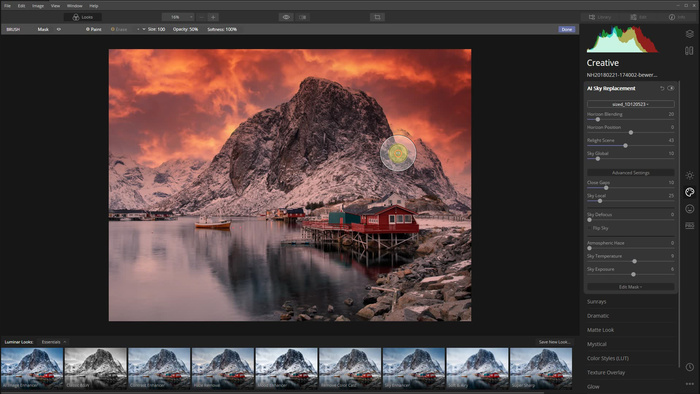
There are two more masking options: A Gradient Mask and a Radial Gradient Mask. I clicked the left button and painted the sky in again. This is completely for the sake of example and not because I was clumsy.

Luminar automatically generated a red-colored mask when I started painting.įor the sake of example, I also erased some of the skies. That’s the button I used to mask out the warmth that the sky replacement added to the mountain. Under ‘Paint Mask’, there are two buttons.

This is where you can adjust the brush size (radius), feathering (softness), and opacity. When you click the masking button, TADA! A new panel unfolds: Advertisements It flips the new sky and allows you to take the shadows in the landscape into consideration when recreating a realistic scene.I am not sure if this is age-related or just the world telling me that I need stronger glasses, but below is the icon I missed that opens the masking options. This can be useful when having an image with a shallow depth of field.įlip Sky is useful when you want to change the direction of the image. In other words, it influences how much of the original sky is replaced.ĭefocus softens the sky and gives it an ‘out-of-focus’įeel. Local controls the overlap between the new and old clouds. That has a lot of fine details and edges such as trees. This is a particularly useful tool when working with images Use this slider to introduce the new sky into small holes and gaps that weren’tįilled initially. Gaps is the first of six adjustment sliders found Moving the slider to the right increases the amount of sky that is Global affects how the texture is mixed into the

Move the slider towards the right for a higher Use this tool when colors in the landscape don’t Scene alters the light and colors of your original Position lets you override Luminar’s sky alignmentīy shifting it up or down to your preference. Using a higher value will give a more realistic feel to the image. Realistically, there is often a soft transition so That’s when the following adjustment sliders come in handy:īlending smoothens the transition between theĬurrent and new horizon. There are cases, though, where the sky and image need some fine-tuning. In many cases, the image looks good immediately after choosing a sky from the Sky Selection. don’t include a foreground) and that it’s captured with a mid-range or wide-angle lens. It’s also important that your sky image has a straight horizon, no other objects than the clouds (i.e. jpg file and have a size below 10 megabytes. When using your own sky image, it’s important to remember that the file should be of high resolution, saved in a. You can choose to use one of the sample skies or you can load your own sky by choosing the Load Custom Sky Image… option at the bottom of the Sky Selection menu. The first step is to choose your new sky from the Sky Selection.


 0 kommentar(er)
0 kommentar(er)
